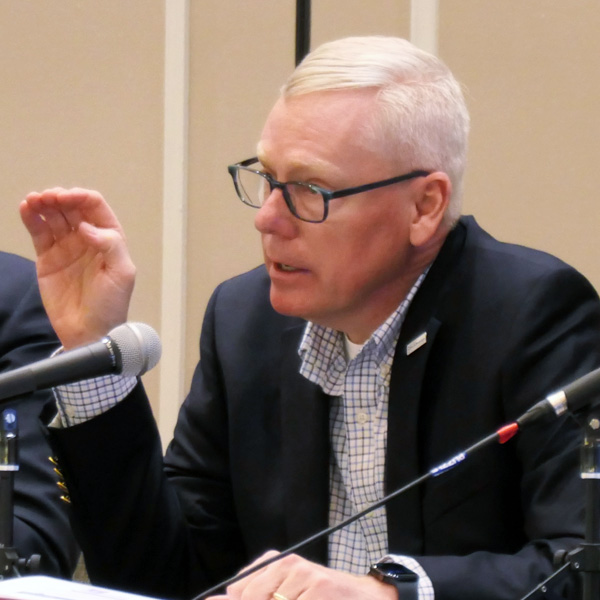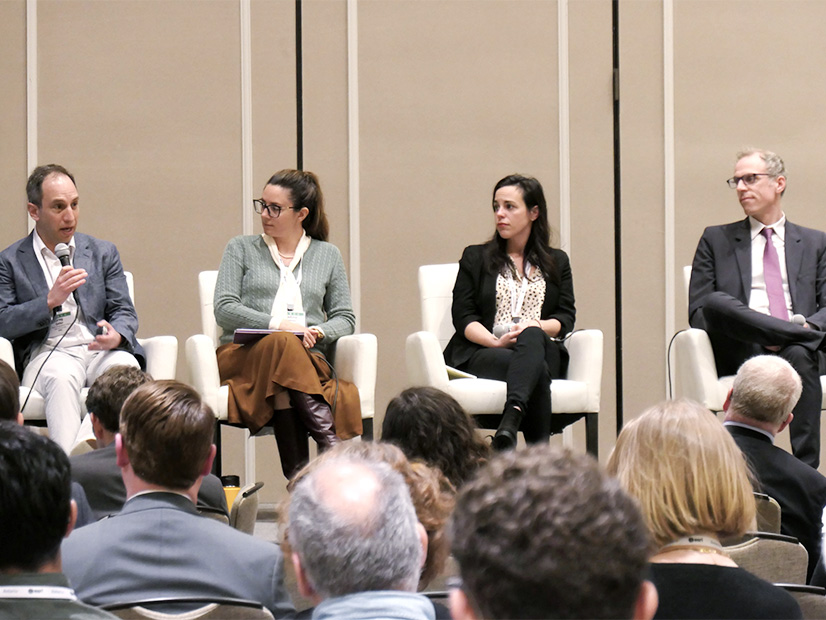NEW ORLEANS — The 2022 annual meeting of the National Association of Regulatory Utility Commissioners covered ground on rate design, energy storage and reliability as the energy portfolio undergoes renovation.
The meeting, which began Sunday and concludes Wednesday, continued NARUC’s multiyear theme of innovative and disruptive technology and regulation.
“The energy transition poses the greatest threat to reliability,” said NERC Director of Legislative and Regulatory Affairs Fritz Hirst during a briefing Sunday on the reliability organization’s 2022 Winter Reliability Assessment.
Hirst called NERC’s summer assessment a “sobering report.”
“And the winter assessment is no exception,” he said, adding that a large portion of the country will confront reliability risks should severe winter weather strike.
 NERC’s Fritz Hirst | © RTO Insider LLC
NERC’s Fritz Hirst | © RTO Insider LLCHirst said Texas, MISO, SERC and New England are particularly exposed to winter risk, due to generation retirements, fuel supply and generator vulnerability to the elements.
He added that the Pacific Northwest’s hydropower conditions have improved since last year and SPP has added enough natural gas and wind generation to manage winter resource adequacy, likely keeping them off the season’s hot seat.
Hirst said it’s “cold comfort” that the National Oceanic and Atmospheric Administration is predicting a mild winter for much of the country.
“It matters not what the predictions are because all it takes is a cold snap lasting several days in a region,” he said.
Hirst also said an ongoing nationwide shortage of transformers might mean longer restoration times. He said that though NERC cannot mandate resource adequacy, the “energy sufficiency challenge” is top of mind for staff. The agency’s consideration of a standard for forward-looking energy reliability assessments seeks to tackle the burgeoning issue, he said.
“The system needs flexible, dispatchable resources, whether that’s coal or natural gas,” Hirst said. “Natural gas is probably your best bet … and that will be the case until we have some breakthrough in storage at scale or in hydrogen.”
Michelle Bloodworth, CEO of coal lobbying group America’s Power, said she’s alarmed by the pace at which dispatchable resources are exiting the grid. She said operators are “vastly underestimating” the amount of coal resources poised to exit the system.
Utilities have announced the retirement of more than half of the nation’s 200 GW coal fleet by 2030, Bloodworth said. She said the industry should “do a better job of publicly recognizing” that coal resources have reliability attributes that are essential for the foreseeable future. America’s Power has filed a letter with FERC, asking the commission to acknowledge those attributes.

“Every coal plant that leaves puts more and more pressure on the natural gas system,” said Bloodworth.
She added that she hoped carbon capture and sequestration investments on the nation’s existing coal plants are given an assist by the Inflation Reduction Act.
“It takes time and sustained investment. We’ve seen more subsidies on the intermittent generation to date,” she said.
State regulators also wrung their hands over natural gas price increases.
During a Monday roundtable, Colorado Public Utilities Commission Chairman Eric Blank said customers will see increases north of 60% on the natural gas portions of their bills.
“It’s just enormous, enormous,” Blank said. “I would say the regulatory options are very limited. We’re just struggling.”
He said “it’s a lot more fun” to regulate when fuel prices are stable. He asked other regulators for ideas on limiting bill increases.
Regulators suggested prohibiting utilities from earning a return on natural gas power purchases, customer charge suspensions, and more robust energy efficiency programs that hedge high commodity prices.
Some regulators said while surging natural gas prices will strengthen some commissions’ commitment to electrification, renewable energy and hydrogen substitution, others will concentrate on how to blunt the price hikes.
“It’s going to be an ugly time for ratepayers in Georgia in the next few months,” Georgia Public Service Commissioner Tim Echols predicted.
“Is the final word from this session, ‘This job sucks?’” Blank joked. “Is that the takeaway?”
Rate Design Considerations
Debbie Lew, associate director of the Energy Systems Integration Group (ESIG), said zero marginal cost renewable resources and looming, immense electrification loads mean that regulators will have to introduce more dynamic pricing that incentivizes demand when supply is plentiful.
“New electrification loads are a double-edged sword — they can help or stress both the distribution and bulk power system,” Lew said during a Sunday panel. “We know we’re going to need more than time of use rates.”
 ESIG’s Debbie Lew | © RTO Insider LLC
ESIG’s Debbie Lew | © RTO Insider LLCBut Lew said time-of-use rates are beneficial today. She said Sacramento Municipal Utility District’s TOU rate created on a $5 million investment averted the need for a new, more expensive 150-MW resource to meet peak demand.
Lew said if regulators want demand flexibility, they will need to expose some customers or load-serving entities to price signals that “reflect cost causation and grid needs.”
“If all demand were price-sensitive, we might not need … reserve margins. Obviously, we’re a long way away from that,” she said.
Brattle Group principal Sanem Sergici focused on electrifying heating with heat pumps. She called their adoption “a key component of state and city climate action plans” but said adoption hinges on their installation and operating affordability compared to natural gas.
Sergici said regulators must design new rate structures that balance customers’ payback periods, fixed charges and incentives under the IRA. She said it’s possible to use cost-based rates and avoid subsidies to foster heating electrification.
“With the right rate design, adoption is possible. It’s time to stop discouraging electrification of heating,” she said, adding that rate design can be “a constant evolution” if the bulk electric system becomes winter peaking.
Storage Makes an Entrance
Jason Burwen, American Clean Power Association’s vice president of energy storage, told regulators to expect 10 GW of new storage annually nationwide for the foreseeable future if transmission system planning is updated, regulatory and permitting processes are revamped, and supply chain issues stabilize.
He predicted the IRA will counteract some of the recent inflation-based price increases of storage facilities.

PJM Manager of Market Design Danielle Croop said PJM has 40 GW of hybrid generation projects and 54 GW of standalone energy storage in its interconnection queue. She said the amount of storage projects likely means that storage is becoming cost effective.
Greg Geller, Enel North America’s head of U.S. and Canada regulatory affairs, said storage is a key component of decarbonization plans. He said regulators can take three steps to stimulate storage additions: collaborate with utilities and grid operators, allow storage to compete to solve grid issues, and give consumers as much cost-causation transparency as possible so they can fire up distributed resources when they stand to save the most.
Geller said Texas, in particular, has an alluring regulatory environment. Enel’s storage projects in the state usually make it through the interconnection queue in one or two years, he said. Elsewhere, the wait is upward of three years. Geller said that storage solutions might help avoid decades-long stranded costs on more permanent assets.




